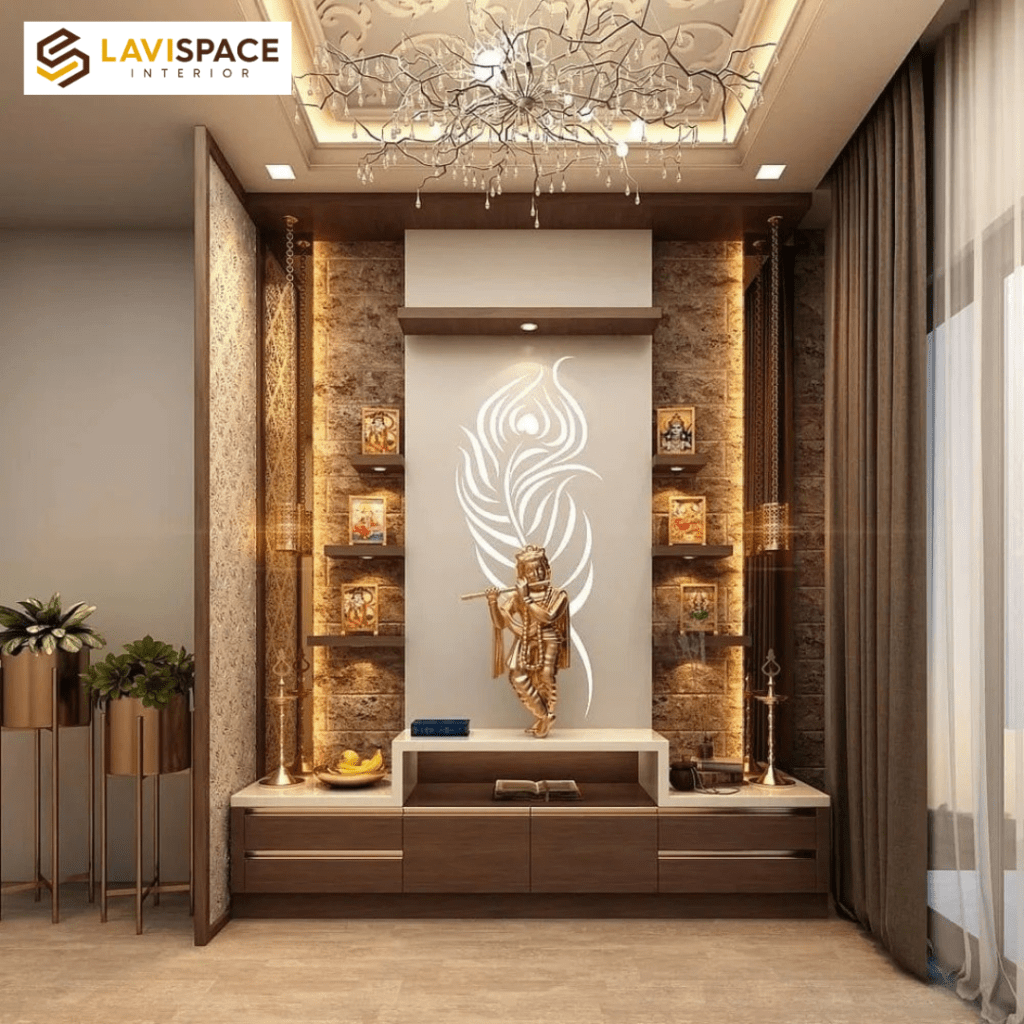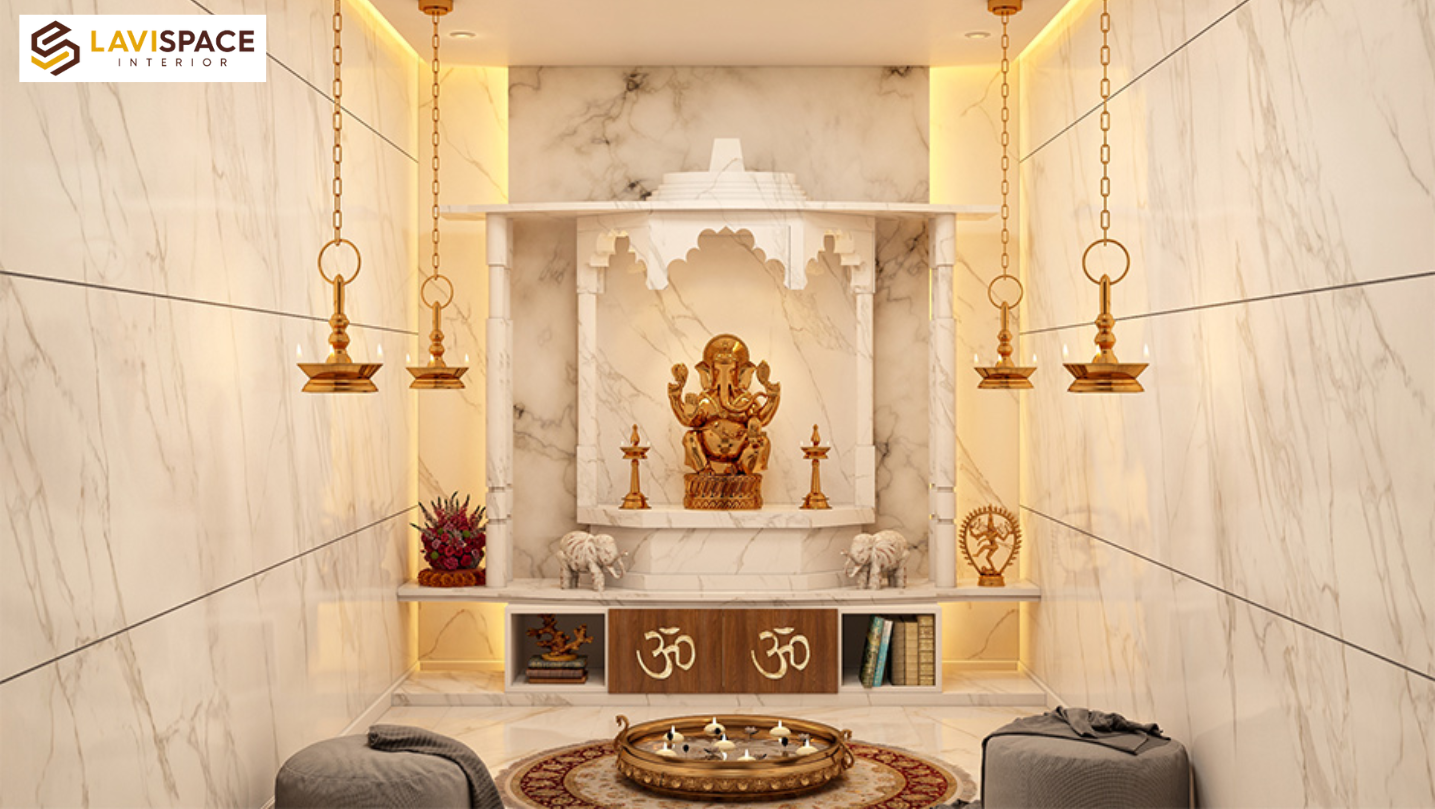Pooja Room vastu ,creating a sacred space in our homes to connect with the divine is an age-old tradition. In Indian culture, a dedicated Pooja Room is significant as it becomes the focal point for prayers and meditation. Adhering to Vastu principles is essential to ensure harmony and positive energy in this sacred space. In this blog, we will explore the concept of a Pooja Room as per Vastu and introduce Lavispace, a revolutionary interior design solution that combines Vastu Shastra with modern aesthetics.
Determining the Best Location for Your Pooja Room Vastu
Northeast Corner: The northeast corner of the house is considered the most promising location for a Pooja Room vatsu. This direction is associated with the energy of the rising sun, symbolizing new beginnings and positivity. Placing the Pooja Room here ensures positive energy and divine blessings inflow into your home.
East or West Facing: When choosing the exact placement within the northeast corner, it is ideal to position the Pooja Room either facing east or west. This allows the devotees to face either north or east while performing rituals, aligning the energy flow with the cosmic forces. Facing east brings in the energy of the rising sun while facing west allows for the soothing energy of the setting sun.
Avoid South Facing: Avoid placing the Pooja Room in the south direction as per Vastu guidelines. The south is associated with the element of fire, which is believed to conflict with the spiritual energy required in a Pooja Room. Placing idols or pictures of deities facing the south direction is also considered inauspicious.
Upper Floors and Basements: If you live in a multi-story house, consider locating the Pooja Room on the ground floor or the first floor. Placing it on the upper floors is generally not recommended, as the energy flow tends to be stronger on the lower levels. Similarly, avoid placing the Pooja Room in the basement, as it may lack the desired natural light and positive energy.
Dedicated Space: Ensure that the Pooja Room has a dedicated space and is not combined with other areas like the kitchen, bedroom, or bathroom. Mixing the Pooja Room with these functional spaces may disrupt the spiritual atmosphere and create disharmony.
Choosing the Right Size and Shape for Your Pooja Room as per Vastu
When designing a Pooja Room as per Vastu Shastra, the size and shape of the room are essential considerations. The dimensions and layout of the Pooja Room contribute to its overall energy flow and create a conducive environment for spiritual practices. The key factors to consider when determining the size and shape of your Pooja Room as per Vastu principles.

1: Dimensions: The ideal size of a Pooja Room depends on the available space in your home and the number of family members using it. However, Vastu Shastra provides some general guidelines to help you create a harmonious space:
Square or Rectangular Shape: The Pooja Room should ideally be square or rectangular. These shapes symbolize stability, balance, and positive energy flow.
Proportional Dimensions: Maintaining a harmonious proportion between the room’s length, width, and height is recommended. For example, a ratio of 1:1:1.5 (length : width: height) is considered auspicious.
Avoid Irregular Shapes: Irregularly shaped Pooja Rooms may disrupt energy flow. Avoiding odd angles or irregular shapes that may create imbalances is best.
2: Space for Circulation: Ensure ample space for circulation within the Pooja Room. Avoid clutter and leave enough room to move around comfortably. This allows for a smooth energy flow and creates a peaceful atmosphere for prayers and meditation.
3: Altar Placement: The placement of the altar within the Pooja Room is crucial. As per Vastu, the altar should be positioned in the eastern or northern part of the room. This allows for positive energy flow and ensures that the devotees face either north or east while performing rituals.
4: Ceiling Height: The height of the Pooja Room’s ceiling also significantly creates a sacred atmosphere. It is recommended to have a higher ceiling than the rest of the house. A higher ceiling symbolizes expansiveness and provides a sense of upliftment and spiritual connection.
5: Natural Light and Ventilation: A Pooja Room should have adequate natural light and ventilation. Natural light is associated with positive energy, and proper ventilation ensures fresh air circulation. However, avoid excessive direct sunlight falling on the altar, as it may cause discomfort during rituals.
Conclusion:
A Pooja Room as per Vastu principles enhances the spiritual ambiance and brings positive energy and tranquility to the entire home. With Lavispace, homeowners can create a sacred space that resonates with their beliefs and aligns with Vastu Shastra.
Lavispace’s commitment to Vastu-compliant design and its focus on contemporary aesthetics makes them the ideal choice for those seeking a harmonious and visually appealing Pooja Room Vatsu. Their attention to detail, expertise in Vastu principles, and wide range of customizable options ensure a personalized experience for each client.




